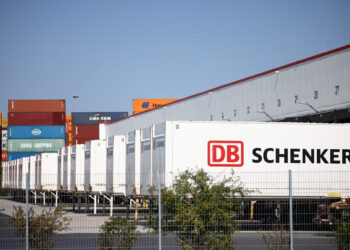Cargolux maps out a new future

What Cargolux said yesterday was that the plan would involve five major initiatives, which we will look at in turn, shedding as much light on them as possible based on Mr. Forson’s comments.
The first initiative was to shore up the company’s financial position, which the Cargolux said would be accomplished by asking shareholders “to commit additional liquidity to the airline, with a first tranche of US$ 100 million requested for the first quarter of 2013 in the form of a convertible loan.” This, however, is only a first step. According to Mr. Forson, “The first $100m tranche is part of a whole request for $275 million. The money will be going into the fleet renewal program and putting more cash into the business. We don’t need cash for operations – on an operational basis the company is cash positive but after loan repayments it gets into negative territory. We will use the cash to improve the resilience of the balance sheet and for the fleet renewal program. We will put some equity into the aircraft and loans. The business is cash sustainable.” Ownership of Cargolux is split among Luxair (43.4%), Banque e Caisse d’Epargne de lEtat (10.9%) and Socieété Nationale de Crédit e d’Investissement (10.7%) and the Luxembourg government. Mr. Forson said that the initial $100 million would come from the three corporate shareholders, with none coming directly from the government, but we point out that these “shareholders” are state-controlled, so the distinction is a fine one.
The second and third initiatives were to “retain the single fleet philosophy and leverage the improved efficiency of the Boeing 747-8 freighter,” and to “pursue profitable, moderate fleet growth and optimize daily fleet utilization.” On this subject, Mr. Forson had several comments. He started by discussing the current fleet, which includes six 747-8Fs, nine 747-400Fs and two 747-400BCFs, but about which he said: “We have seven 747-400Fs in the fleet. Three will be returned to the lessors in the next two to three years. We will have three or four that will be debt free by mid-2014 and cash neutral. This will bring flexibility into the fleet. We may sell one of the aircraft but keep the remainder in service after the financing has come to an end. We have orders for 13 x747-8Fs, the last of which deliver in 2017. We will complete that program plus maintain the 747-400Fs, which will be substantially depreciated and debt-free.” This appears to end speculation that Cargolux would in any way change the status of its 747-8F order – whether through cancellation, deferral, or addition of more orders. The backbone of the fleet will be the thirteen 747-400Fs, rounded out with several 747-400Fs.
A statement today by Cargolux’s new Chairman Paul Helminger sheds further light on this. “There has been talk about giving up our single-type fleet in favor of the B777F. Such a move would merely add to the cost of our operations. Our core fleet of new, more economical B747- 8Fs will allow us to capture the full value of Cargolux’s strength, while keeping several debt-free B747-400Fs in the fleet will add flexibility to our capacity.”
So, an infusion of cash from shareholders, and flexibility on the capacity side provided by the ability to use or park several “debt-free” 747-400Fs, but what about costs? When the Board announced approval of the plan, it said the fourth initiative would be to “achieve permanent efficiency gains and increased levels of flexibility in terms of cost and capacity; involving a range of measures including amendments to the Collective Work Agreement.” Clearly, this means “we are going to cut labor costs,” but given that resistance by the union representing Cargolux’s workers to such cost cutting appears to have been what drove Qatar Airways to sell its 35% stake back to the Luxembourg government, how will Cargolux deal with the problem this time?
According to Mr. Forson, “On the cost side we took out about €60m in costs last year across all cost categories. But we didn’t address labor costs – and that’s going to be the focus of this year – and it’s not just the unionized workforce. We need to permanently reduce the costs and increase the productivity of labor, while ensuring we can have temporary measures available to account for deviations in the market. We will have $1.8 billion in costs in 2013. 47% of that is fuel. The two largest remaining elements are labor and handling/landing/overflight fees. If we reduce the number of hours of flying, we also reduce our fuel costs and the other charges – but the one cost we’re stuck with is labor. That needs to reduce as well. Excluding fuel, labor makes up about 25% to 26% of costs – or about $250m per year.”
Mr. Helminger also addressed that subject in his remarks today, saying: “The shareholders have agreed to inject a substantial amount of additional cash into Cargolux. We have engaged our major suppliers as well to be more competitive in their pricing. There is one additional group of stakeholders who has an important role to play in making Cargolux sustainable on its own, and that’s its employees. They should understand that competitiveness and flexibility is the key to success in the future. If we want to become more competitive, we must reduce our cost by becoming more agile and more efficient, which is also a condition to maintaining unchanged the number of employees throughout the 2013 to 2017 period according to the strategy plan.”
And Mr. Forson again: “I see the Collective Work Agreement as a challenge. It’s the last remaining strand that we need to deal with. We are confident of the other pillars of our strategy but this is the last remaining big challenge. It’s not an option – CWA employees are being requested to and will seriously have to consider this. It’s essential to the future of Cargolux, and I’ve said this to them often enough. Our chairman has said there will be no retrenchment, but has requested that the unions come to the table “
What these statements appear to say is that Cargolux is willing to guarantee jobs if the employees will take a pay cut. Whether this will happen through reduced hours, reduced pay rates, or some combination of these plus other concessions is not known. Mr. Forson said that when the company presented the details of its requests for amendments to the existing Collective Work Agreement, “the unions were non-committal. They wanted time to digest it. They will respond at the next session in March.”
The final initiative in the new plan was to “enhance growth and cost competitiveness and return to profitability in 2014.” This is fairly nebulous, and we have already looked at the “cost competitiveness” part of it. As to the “enhance growth” part, Mr. Forson stressed the need for high utilization of the carrier’s freighters. “We already have 15 blocks hours of utilization per day. We’re at the top of the Boeing league table for utilization. In-house maintenance helps us achieve that. On the sales side, we will identify new markets. Historically we have always managed to maintain high utilization and it is a critical pillar.” What this appears to mean is that in the face of increasingly stiff competition, and in an environment of low or no demand growth, Cargolux will respond by increasing sales and maintaining yields.
But how is this possible? Where will the volume come from? And how will yields be kept up? The answer appears in Mr. Helminger’s statement, in which he said: “According to the strategy and based on a moderately optimistic growth outlook for the air cargo market of 4.5% to 4.5% p.a. on average, Cargolux is expected to show slightly higher than market growth and hopefully post its first full-year profit in 2014.” Obviously, “4.5% to 4.5%” is typographic error on the part of Cargolux’s PR department, but whatever the second figure should be [Carglolux has since informed us that it is 4.8%], this is a major leap of faith. Clearly, the fact that the last two years have seen little growth in demand does not mean demand will stay flat forever, but to assume growth of 4.5% this year or even next seems optimistic.
Finally, we look at the question of the potential sale of the 35% currently held by the Luxembourg government. This was not something addressed in the plan, but following the Qatar Airways debacle it is something that is very much on everyone’s mind. Both CEO Richard Forson and Chairman Paul Helminger addressed it, but in this case both chose to be positive without really saying much. In Mr. Forson’s words: “We are in the process of identifying a replacement for Qatar. We want to finalize it by the end of 2013. There is genuine interest from investors in taking up Qatar’s interest. We are keeping an open mind on everything, and if an investor came in that required a different strategy, we are open to that. It all depends on what they bring to the table.”
Names of the suitors were not announced, but the list is believed to include China’s HNA Group (which lost out to Qatar in the earlier sale). Moscow-based Volga-Dnepr Group is also often mentioned as a candidate, but not only did it buy a 49% stake in Frankfurt-based Air Cargo Germany last year (seemingly eliminating any need to invest in another European carrier), it has also lost money for the last two years and is forecasting only a nominal profit in 2013. Japan-based Nippon Cargo Airlines (NCA) has also been mentioned. NCA is facing its own difficulties, but is known to be considering relationships with other carriers as a possible solution. Whether a tie-up with Cargolux would provide that solution is an interesting question. Their combined fleets would include twenty-seven 747-8Fs, and their combined networks and traffic rights would be impressive, but the extent of the cost-saving, profit-improving synergies, if any, is unknown.
The world of air freight has changed drastically over the last ten years, and it is not clear what the future holds for independent all-cargo carriers. Cargolux, Nippon Cargo Airlines, and AirBridge Cargo are, if we can mix a metaphor, flying into uncharted waters. To some extent, labor costs are within their control, and if demand surges and fuel prices drop (or at least don’t rise any further), the three carriers have a good chance of returning to profitability. But the competitive landscape is different than it was ten years ago, and if demand stays flat (or rises at less than 4.5% per year), and/or if fuel prices rise, they will have a difficult time competing against carriers who can offer forwarders and shippers cheap belly space in huge widebody passenger fleets.
Learn more about the situation facing all-cargo operators at Cargo Facts Asia 2013, register here.




